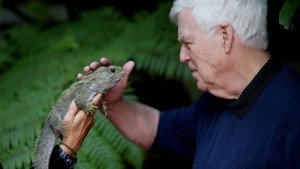The Dominion Post‘s Olivia Wannan looks at how sequencing DNA from the tuatara could help conservationists develop a better way to bring it back from the brink of extinction.
Olivia is a finalist in the Reporter Science and Technology category for this year’s Canon Media Awards.

An excerpt (read the story in full here):
Forget animal attraction – the perfect mate for a tuatara might best be found through a blood test.
World-leading biologist Stephen O’Brien, currently in New Zealand, has looked at the DNA extracted from blood, feathers and saliva of threatened animals for almost four decades. The information has helped conservationists to anticipate the hidden dangers, such as inbreeding and disease, that could wipe a species out.
“We can learn so much more … The tendency to avoid sampling because it might inconvenience the individual is a concern that is, in my opinion, stupid.”
The full genome of the tuatara, which was until recently extinct on the mainland, is currently being sequenced at the University of Otago.
Previous DNA work has found, rather than the two species previously thought, there was just one species of tuatara split into two sub-species.
O’Brien said new genetic data from the Otago project could, for example, tell scientists whether it was a good idea to breed these two sub-species together or whether they are so different that their offspring could suffer as a result.
“You never really know what you will find until you take a look,” he said.
“Every [endangered species’ situation] is different. It’s sort of like a poker hand. Sometimes you get a total bust, sometimes you’re in the middle somewhere and you might do OK, and sometimes you’ll get a royal flush, and they’re better off.”